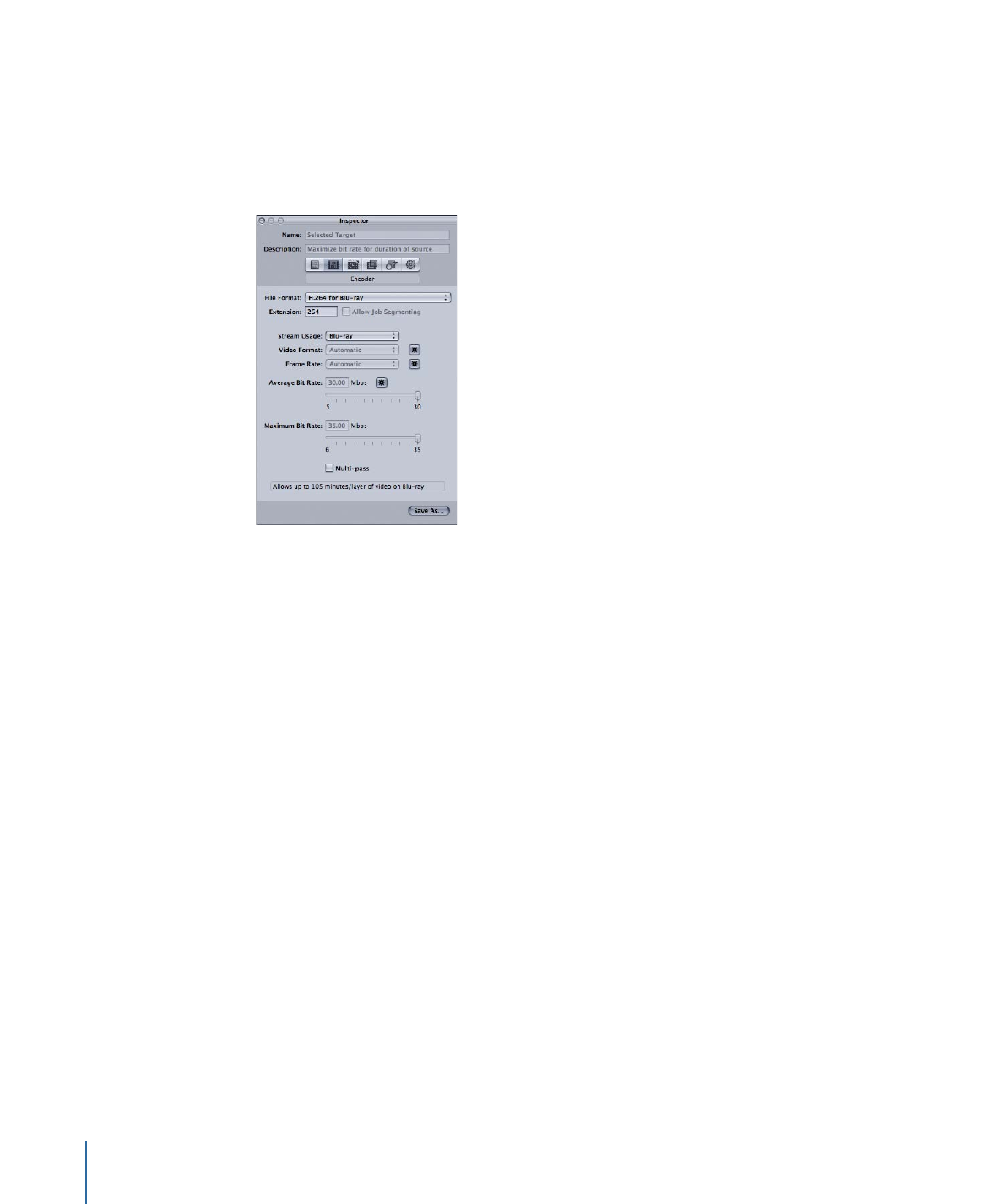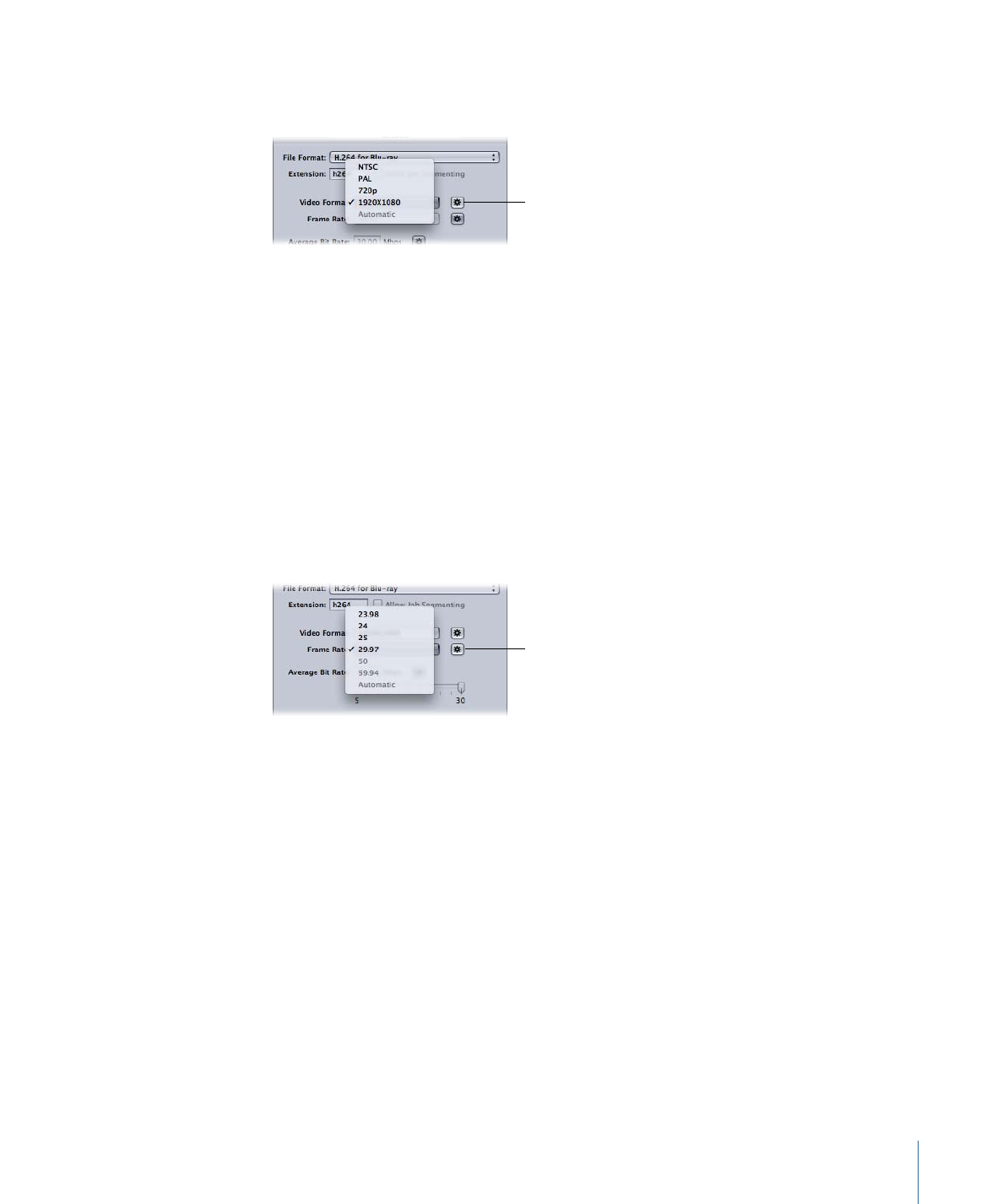
About the H.264 for Blu-ray Disc Encoder Pane
This section contains detailed information about the elements of the H.264 for Blu-ray
Disc Encoder pane in the Inspector window. You make your H.264 for Blu-ray Disc settings
using this pane, by either modifying an existing setting or creating a new setting in the
Settings tab.
The H.264 for Blu-ray Disc pane contains the following items.
• File Extension field: Displays the H.264 for Blu-ray file extension (.264) automatically
after the H.264 for Blu-ray output format is chosen from the File Format pop-up menu
or the (+) pop-up menu in the Settings tab.
• Allow Job Segmenting: This checkbox allows you to turn off job segmenting. It is relevant
only if you are using Compressor with distributed processing and with multi-pass
encoding. For more information, see
Job Segmenting and Two-Pass or Multi-Pass
Encoding
.
• Stream Usage: Use the Stream Usage pop-up menu to choose how you intend to use
the H.264 stream. Compressor modifies the bit-rate range settings based on the usage
you choose with this pop-up menu.
• Blu-ray: Choose this if you intend to use the stream to create a standard Blu-ray disc.
• AVCHD: Choose this if you intend to use the stream and the Create Blu-ray Disc job
action to burn an AVCHD disc using a standard DVD burner. This disc can be played
in Blu-ray Disc players that are compatible with the AVCHD format. AVCHD discs can
have up to a maximum of 50 chapter markers.
• Video Format: Use the Video Format pop-up menu to choose from the four options
listed below. All of them are HD progressive formats.
166
Chapter 14
Creating H.264 for Blu-ray Disc

The Video Format setting also has an Automatic button. Clicking the Automatic button
causes the encoder to choose the video format that matches the source video file.
The Video Format
Automatic button
• NTSC: This format is referred to as 480p. It uses a 720 x 480 frame size with an
anamorphic 16 x 9 format at 59.94 fps.
• PAL: This format is referred to as 576p. It uses a 720 x 576 frame size with an
anamorphic 16 x 9 format at 50 fps.
• 720p: This format uses a 1280 x 720 frame size with a 16 x 9 format at either 59.94 fps
for NTSC or 50 fps for PAL.
• 1920x1080: This format is referred to as 1080p. It uses a 1920 x 1080 frame size with
a 16 x 9 format at either 59.94 fps for NTSC or 50 fps for PAL.
• Frame Rate: Use this pop-up menu to choose a frame rate for the output media file.
The Frame Rate setting also has an Automatic button. Clicking the Automatic button
causes the encoder to choose the frame rate that matches the source video file.
The Frame Rate
Automatic button
Note: If you choose a format in the Video Format menu, the Frame Rate menu will be
filled in automatically.
Use the Frame Rate pop-up menu to choose from the following options:
• 23.98: Used for NTSC-based video
• 25: Used for PAL-based video
• 29.97: Used for NTSC-based video
• 50: Used for PAL-based video
• 59.94: Used for NTSC-based video
167
Chapter 14
Creating H.264 for Blu-ray Disc

• Average Bit Rate slider and field: Choose an average bit rate to use for the output video
with the slider, or enter a value directly. While the available range for a Blu-ray disc is
between 5 Mbps and 30 Mbps, typical video bit rates with H.264 might range from
7 Mbps to 15 Mbps, depending on your DVD bit budget and the nature of your source
media files. The available range for AVCHD discs is 5 Mbps to 15 Mbps.
• Maximum Bit Rate slider and field: Choose a maximum bit rate between 6 Mbps and
35 Mbps for a Blu-ray disc, or between 6 Mbps and 17 Mbps for an AVCHD disc. You
can also enter any number within these ranges into the accompanying field. The
Maximum Bit Rate setting cannot be lower than the Average Bit Rate setting. As a
general rule, set your maximum bit rate at least 1 Mbps higher than your average bit
rate, to allow for bit-rate variability in achieving the goal of constant quality.
• Multi-pass: Use this checkbox to turn on multi-pass encoding. Similar to two-pass
MPEG-2 encoding, multi-pass offers the best possible quality. For faster (single-pass)
encodes, turn this feature off by deselecting the checkbox. See
Job Segmenting and
Two-Pass or Multi-Pass Encoding
for more information.